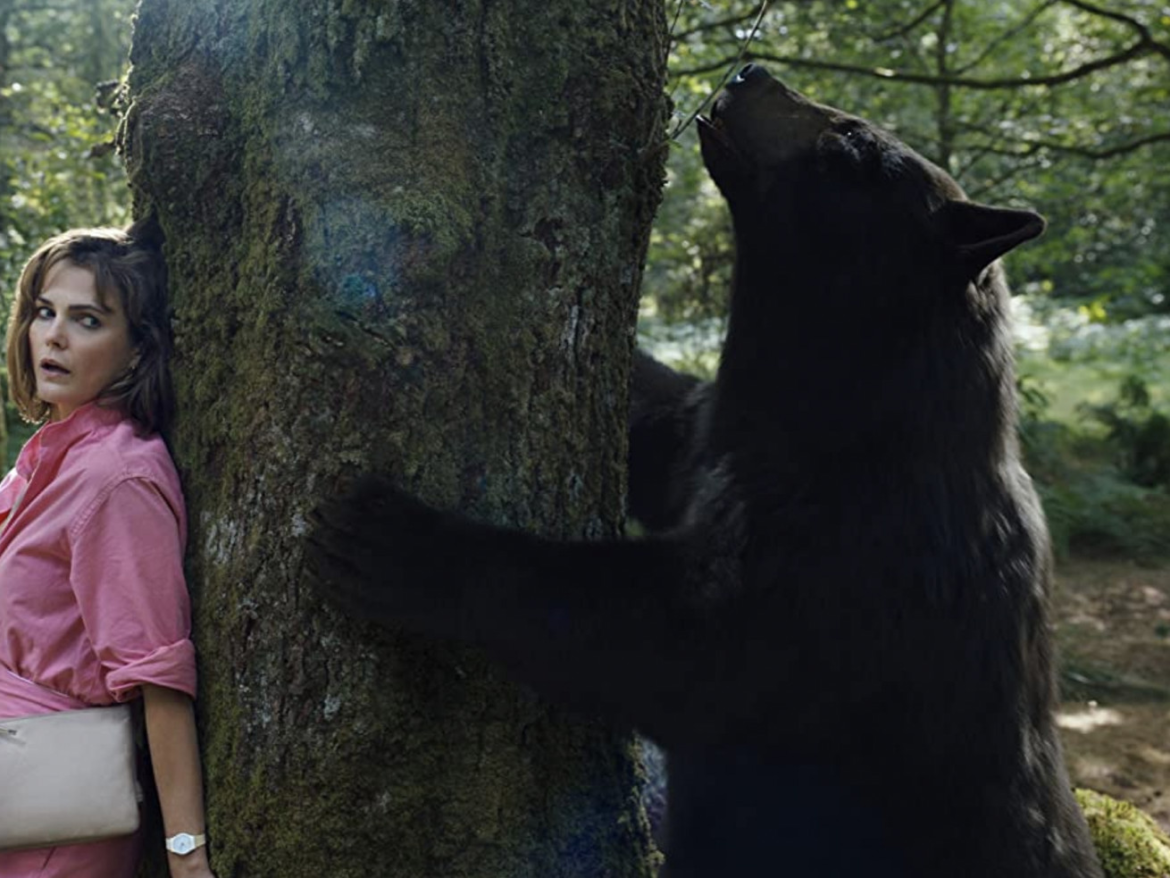Does a bear do mushrooms in the woods? Maybe.
Hollywood loves to tell stories about cocaine.
Hollywood also loves to tell stories about bears.
Given these two passions, it was only a matter of time before Hollywood would combine its two loves into the film extravaganza of 2023: Cocaine Bear.
As its name plainly suggests, the movie will tell a story about what happens when a majestic animal comes into contact with an illegal, powerful, and expensive narcotic. Cocaine is consumed. A bear goes wild. Humans are eaten.
Cocaine Bear, directed by Elizabeth Banks, is loosely based on a true story. Back in September of 1985, convicted drug smuggler Andrew Thornton allegedly dropped around 75 pounds of cocaine from a plane. Thornton had jumped from the plane himself, but the load was too heavy to carry safely to earth, and the loot landed somewhere along the Georgia-Tennessee border. There, according to the medical examiner at the time, a mountain bear had reportedly ingested “three to four grams” before dying, the AP reported.
Except for Thornton, who died from his ill-fated parachuting attempt, no people were killed. The only animal harmed was the bear. And we don’t even know what really happened to the bear.
While Cocaine Bear takes some liberties in telling a carnivorous comedy, I wanted to know the real answer to the question sparked by this movie: What happens if a bear does cocaine?
I took this query to Chris Morgan, an ursinologist (a person who studies bears) and ecologist whose work focuses on conservation. As Morgan, who was in the Everglades, explained to me, bears are a lot smarter than they’re portrayed in pop culture, and their complex brains would probably be affected by cocaine. (Morgan also sent me a picture of himself holding a python that had just swallowed a raccoon.) While he highly doubts that members of the ursine family are burying their snouts in mountains of coke, he says there may be some partaking in some naturally-occurring highs. But perhaps the most important thing about Cocaine Bear, Morgan says, is that it has the potential to be a story about how human actions have direct consequences on bears, rather than the other way around.
Have you ever encountered a bear on cocaine before?
I have not. The bear in Cocaine Bear may be the only bear with that habit.
Cocaine is also expensive. I don’t think people who like cocaine are just casually handing it out to bears.
Most definitely not.
So, theoretically, what would you think would happen if you gave cocaine to a bear?
Well, it’s really hard to say, I mean, the sample size of bears doing cocaine is very small. I’ve got no personal experience with that, but I would think that physiologically, the bear would go through some of the very similar sort of characteristic traits that humans might have on cocaine — sort of amplified behavior that makes them a little crazy. And if that bear ate as much as I heard — you know, a big portion of cocaine — then that’s a death sentence for the bear just like it would be for humans.
Cocaine is obviously a stimulant, and I think the bears are portrayed in pop culture as being sort of chill if not lazy. They’re famous for hibernating. And I think the compelling thing about Cocaine Bear is that the bear goes on a rampage. We’re not used to that image of a bear that’s very aggressive and hyped up on life.
/cdn.vox-cdn.com/uploads/chorus_asset/file/24436082/image__1_.jpeg)
Universal
People are more used to the Yogi or Baloo or, you know, Smokey the Bear. They have that sort of image — not a cracked-out bear in the forest. So it’s hard to imagine what a bear like that would be. But I gotta say that bears in nature, they hit this thing in around fall, this thing called hyperphagia, which literally means excessive eating. They get the munchies in a big way. And that helps them get through the winter. If they eat enough in the fall, they gain all this fat, and then they can sleep all winter.
If they don’t gain all that fat, they can’t sleep. They might also end up dying, or females might end up not giving birth to their cubs, all kinds of things. So they get into this massive phase of eating full time.
They actually get more aggressive usually in the fall because of that, and, you know, because they just become lean, mean, eating machines, to be ready for the winter and to stock up on the pounds.
So, theoretically, if this cocaine drop happened during the fall, it’d be even worse for the bear because the bear’s senses are already heightened.
I mean, it’s all conjecture, but it’s probably safe to say it wouldn’t help. It would only amp the bear up. I feel bad for that bear, it must have been a hell of a confused bear, you know?
It probably didn’t understand why it felt so awake and was having the worst trip of its life.
Speaking of trips, in nature you have psychedelic mushrooms. And I’ve read some stories of animals getting drunk or high off of naturally occurring chemicals in plants and animals. Do you know if that happens to bears too?
There’s not much known about it. But as a lot of people know, there are mushrooms that are full of psychedelics and bears eat mushrooms. It’s got to have happened. But the science is really out there on how much it’s occurred.
So, if a bear eats psychedelic mushrooms in the woods and no one’s there to see it …
Does it really trip? I think that’s a PhD thesis waiting to happen, isn’t it? I don’t know!
But I will say that these are smart creatures with a lot going on, massively developed brains, high intelligence, high ability to assess situations, high ability to remember things, especially where food locations are. Bears will often eat up to 100 different plant species out in the forest, and they know where they are and when they’re there.
And some scientists have even suggested that the bears will clue into medicinal use of plants.
My point is that there are all these different plant species, and bears are very good at closing in on them. A lot of those are mushrooms, bears don’t shy away from them. And with their high-level brains just like ours, psychedelic mushrooms have got to affect them. I’m almost certain that there are bears out there that have had hallucinogenic experiences. I don’t think I want to meet one of them.
I’m sure if they’re tripping, they just want to be left alone. Like, theoretically, if I was a bear and I just ingested some ’shrooms, I would just post up next to a river and lie down.
Don’t tell me you’ve not done it! But yes, I think that’s what any wise bear on mushrooms would do: just chill out and enjoy it. And it’s probably the polar opposite to a bear on cocaine.
So I think one of the ideas behind Cocaine Bear is that it’s obliquely about human waste. The bear didn’t choose to procure cocaine. A person — in both the real-life story and the movie — threw it out.
Human waste is poison to a bear. Whether it’s a doughnut or a bag of cocaine, it doesn’t much matter if it comes from humans. It’s highly processed, and it’s dangerous for wild animals, and usually ends up in their death, if not the death of a human.
/cdn.vox-cdn.com/uploads/chorus_asset/file/24450580/Chris_with_brown_bear_in_Alaska__1_.jpg)
Brenda Phillips
If a bear gets into garbage, it’s usually the end of them, because garbage to a bear is highly addictive. Especially in North America, people’s garbage or birdseed in birdfeeders, believe it or not, are these huge attractants that pull bears out of the wild into backyards. They can’t quit because it’s an easy meal full of calories. They sort of get addicted. That’s what they need, you know, easy meals.
I’m assuming if they’re smart enough to find berries and food sources in the wild, they’re smart enough to keep coming back to garbage cans and whatnot.
Yes, they become habituated, and if they get addicted, they become human food conditioned. They think, “Oh, easy meal, I’m going to come back every single Wednesday when the garbage can is out.”
Bears are opportunistic omnivores, you know, which is a really cool phrase to describe them. They’re used to finding opportunities, keying in on them, and remembering them and coming back to them repeatedly.
They’ll keep on coming back [into these human neighborhoods]. And that’s usually when they have to be euthanized.
Because they’ll run into humans.
You know, in Cocaine Bear, that bear ends up killing people, but in the real story, that bear didn’t kill anybody. And that’s another thing, it’s such a rare occurrence that bears attack people and especially kill them.
I mean, it sounds like it’s a little bit like Jaws, right? Sharks don’t really kill that many people. But everyone knows Jaws. And I think this probably applies to bears too, but the people who get killed by sharks go to the sharks’ home. If you stay out of the sharks’ home, the shark can’t kill you!
Exactly. The thing is, everyone loves a great headline, right? It’s why sharks make the headlines. It’s why bear attacks make headlines. There’s a million bears in North America, black bears and grizzly bears combined, there are one or two people a year on average that are killed by them. [In 2021 and 2022, bear attack fatalities have risen, as have bear-human conflicts.] These really aren’t dangerous creatures unless you find yourself in an unusually tricky predicament.
I kind of feel like if you’re getting eaten by a bear, there were probably a set of events that got you to that point. I don’t want to blame the victim, but it just seems that there are a lot of things that need to happen in order for you to get mauled by a bear. Humans probably threaten bears on a greater scale than bears have done to us.
There’s eight bear species in the world, and six of them are threatened with extinction. Because they’re these big, smart, wide-ranging creatures that need some of the similar things that we need — food, space, water — they end up losing out because we’re the more powerful cousin.
My work and the work of lots of other people is really trying to just change that attitude toward these wild creatures and give them the little bit of space they need on our planet to survive.
Grizzly bears in the north of North America are a great example. Before European settlers arrived, a couple of hundred years ago, across North America’s west, there were probably 50,000 to 100,000 grizzlies. Now, there’s more like 2,000 in the lower 48. So we’ve reduced them down to 2 percent of their former historic range. Two percent! And they are clinging on to the mountaintops, in these wild, wild places where we can’t get to them and destroy their habitat.
I think that these creatures represent so much to us, in terms of the wild and representing what is left in the wild, we don’t have many opportunities to protect creatures like this. They deserve our attention and help. There’s a lot going on between the ears of these bears — they’re very smart, complex, individualistic — that we need to respect and celebrate.
And don’t give them cocaine. Never give them cocaine.
That’s the next Smokey the Bear poster!



